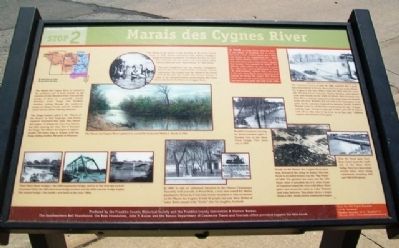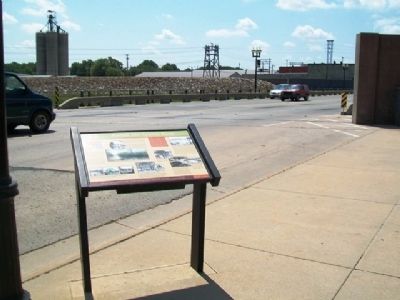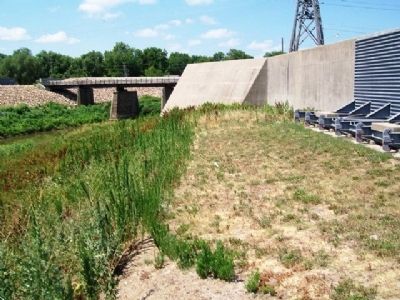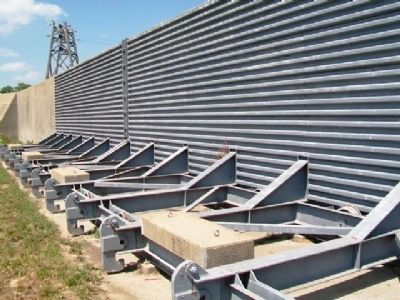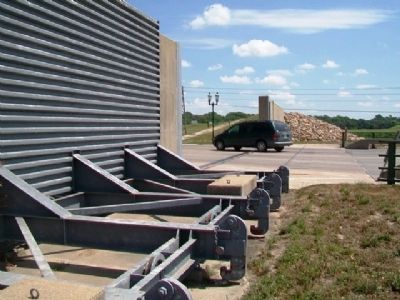Ottawa in Franklin County, Kansas — The American Midwest (Upper Plains)
Marais de Cygnes River
Historic Ottawa Tour Stop 2
"The Marsh of the Swans" is the meaning of the river's French name. In 1828, Baptist missionary Isaac McCoy brought a group of Indians on a journey to examine this area as a possible relocation site for eastern and Great Lakes tribes. McCoy called the river "Miry Desein" or "Miry Swan".
The poet Longfellow has his heroine, Evangeline, travel to this area in search of her sweetheart, Gabriel La Jeunesse. She camped near the Marsh of the Swans river in the area that would later become Kansas. A story of two thwarted Indian lovers turning into swans also is attached to the Marais des Cygnes River.
The Marais des Cygnes River is formed in the northeast part of Lyon County by the junction of One Hundred Forty-Two and Elk Creeks. It flows in a generally easterly direction across Osage and Franklin counties, cutting through the southwest corner of Miami County and the northeast corner of Linn before entering Missouri.
The Osage Indians called it the "Marsh of the Swans" in their language, and French explorers translated that name into Marais des Cygnes. In Kansas the river is so known, but after crossing the state line it becomes the Osage. The Marais des Cygnes is approximately 150 miles long in Kansas with the Osage adding another 300 miles in Missouri.
[Inset illustration caption] The Marais des Cygnes River captured in a pastel by local artist Mattie L. Hardy in 1916.
A ford is a place where, when the water is low, people on horseback and in wagons can cross a river. Gradual banks and a solid rock bottom are the requirements for a good ford. Where Hickory Street would cross the river (one block east of Main Street) a gentle ford existed. First operated by Indians and later by white settlers, it came to be called the "Ohio City" ford to distinguish it from "Ft. Scott Crossing," another ford a few miles to the east where the Ft. Scott-California Trail crossed the Marais des Cygnes. This Hickory Street ford was still used by Ottawans until the new flood control levees were built in the 1960s.
The Wyandotte Gazette in June 30, 1866, reported that a good ferry boat (similar to the one above) had been put on the Marais des Cygnes at the new Ottawa town site, then only two years old. The first known ferryman, Charles Robbins, often played cards with friends on the south riverbank when business was slow. Once a customer appeared on the north bank and shouted across the river. Robbins did not wish to be interrupted in his game, but the customer clamored for attention. Finally, Robbins shouted across to ask him how much money he had. "A dime," said the man. "If you've only got a dime, you will be just as well off on that side of the river as on this side,"
Robbins replied, and returned to his game.
Three Main Street bridges - the 1868 suspension bridge, said to be the first one west of Cincinnati (left [photo]), the 1883 steel truss bridge (center [photo]) and the 1926 concrete bridge (right [photo]). The current bridge - the fourth - was built in the early 1980s.
In 1883, to add an additional attraction to the Ottawa Chautauqua Assembly held annually in Forest Park, a local man named S.F. Beeler purchased a 32 foot by 8 foot sidewheeler steamboat to take excursions on the Marais des Cygnes. It held 40 people and only drew 10 feet of water. Beeler named it the "Gertie" after his daughter, Gertrude.
Floods on the Marais des Cygnes River have long disrupted life along its banks. The first flood in recorded history was the "Big Water" of 1844. The greatest one since was the 1951 flood. After it subsided, the U.S. Army Corps of Engineers tamed the river with dikes, flood gates and reservoirs such as Lake Pomona and Lake Melvern. This photo shows a major flood in 1961, shortly before construction began.
Franklin Countians viewing an all-too-common sight - a flooded river at the Main Street bridge. This flood was in 1915.
Note the flood gates have been closed across the south end of the Main Street bridge. They have been closed several times since being constructed, including 1993 and 1998 (1993
photo).
Erected by Franklin County Historical Society, Franklin County Convention & Visitors Bureau, and Others.
Topics. This historical marker is listed in these topic lists: Disasters • Settlements & Settlers • Waterways & Vessels. A significant historical month for this entry is June 1955.
Location. 38° 37.149′ N, 95° 16.121′ W. Marker is in Ottawa, Kansas, in Franklin County. Marker is at the intersection of Main Street and the Floodwall, on the right when traveling south on Main Street. Touch for map. Marker is at or near this postal address: 212 North Main Street, Ottawa KS 66067, United States of America. Touch for directions.
Other nearby markers. At least 8 other markers are within walking distance of this marker. Old Depot Museum (about 600 feet away, measured in a direct line); 1951 Marais des Cygnes Flood High-Water Line (about 600 feet away); a different marker also named Old Depot Museum (about 600 feet away); Company K, 20th Regiment Kansas Volunteers (approx. ¼ mile away); Main Street, 200 Block South (approx. ¼ mile away); Shepherd & McQuesten Building (approx. ¼ mile away); Pickrell Building (approx. ¼ mile away); The Down Town Ottawa Historic District (approx. ¼ mile away). Touch for a list and map of all markers in Ottawa.
Also see . . .
1. Marais des Cygnes River. Wikipedia entry (Submitted on December 29, 2021, by Larry Gertner of New York, New York.)
2. "Ferries in Kansas, Part XV, Marais des Cygnes River," in Kansas Historical Quarterly (1937). Kansas Historical Society website entry (Submitted on August 15, 2013, by William Fischer, Jr. of Scranton, Pennsylvania.)
3. Franklin County, Kansas, Historical Portal. Website homepage (Submitted on August 16, 2013, by William Fischer, Jr. of Scranton, Pennsylvania.)
Credits. This page was last revised on December 29, 2021. It was originally submitted on August 15, 2013, by William Fischer, Jr. of Scranton, Pennsylvania. This page has been viewed 826 times since then and 49 times this year. Photos: 1, 2, 3, 4, 5. submitted on August 15, 2013, by William Fischer, Jr. of Scranton, Pennsylvania.
